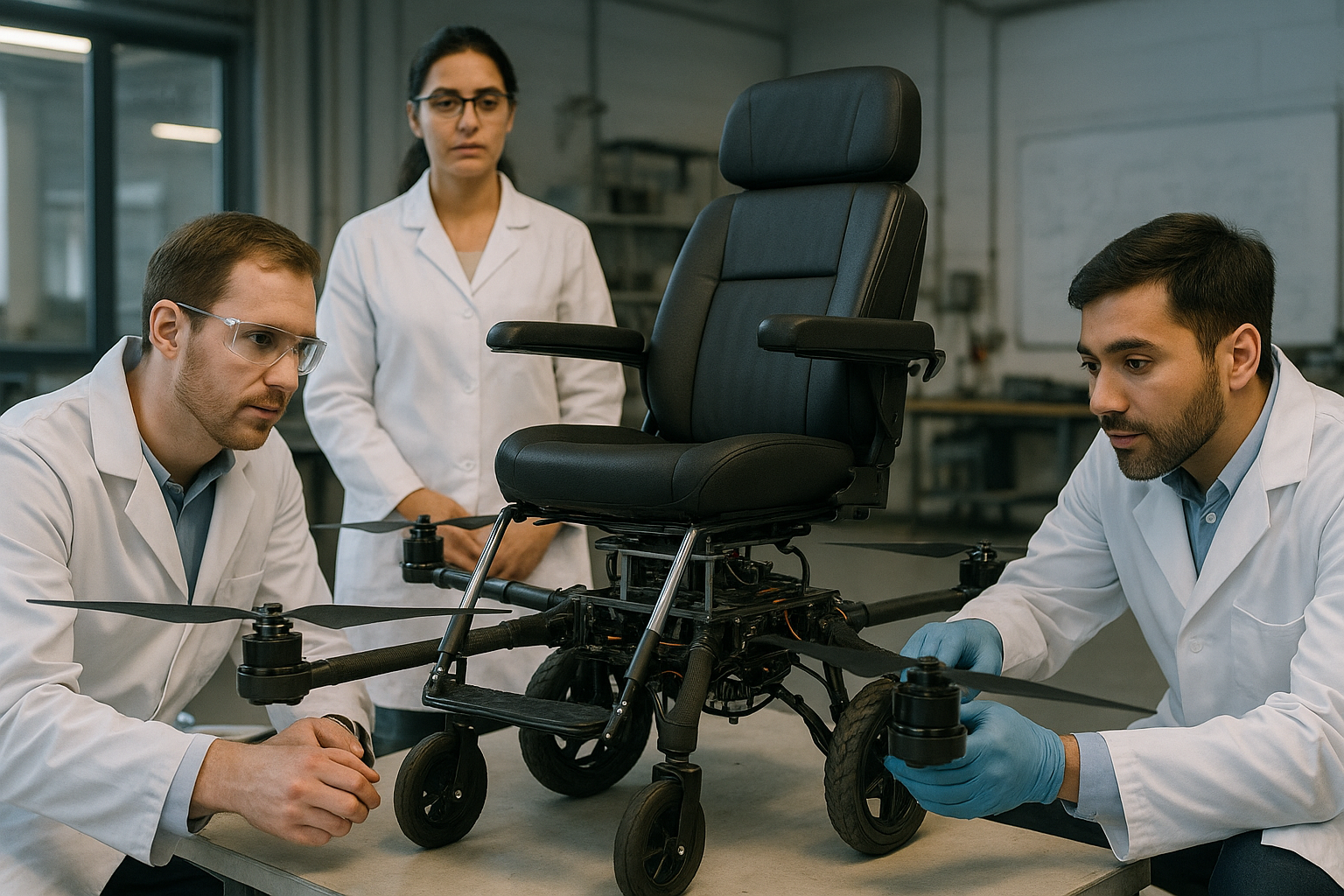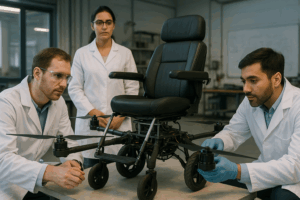Is It Possible for Drone Wheelchairs to Become a Reality in the Future?

Vision of Mobility Beyond Limits
Imagine a wheelchair that not only moves across flat surfaces but can lift off the ground, fly over obstacles, and provide unmatched freedom of movement. While it may sound like science fiction, the idea of drone wheelchairs—aerial mobility devices for individuals with physical disabilities—is gaining attention. The central question is: Is it actually possible for drone wheelchairs to become a real, usable product in the future?
In this article, we’ll explore this concept in depth: what drone wheelchairs are, what technology would be required, the benefits they offer, the challenges they must overcome, and how close we really are to making them a part of everyday life.
What is a Drone Wheelchair?
A drone wheelchair is a mobility device that merges the functionality of a traditional electric wheelchair with the flight capabilities of a drone. It is designed to:
-
Move on the ground like a standard powered wheelchair.
-
Lift vertically into the air to fly short distances.
-
Navigate both physical terrain and vertical barriers.
Unlike regular wheelchairs, which are limited by architectural structures (e.g., stairs, curbs, and uneven ground), drone wheelchairs would theoretically provide access to any location—making the world more accessible.
Is the Technology Available Today?
Let’s break down the core technologies that would power a drone wheelchair and assess where we stand today:
1. Flight System (Propulsion + Stability)
-
Current State: Drone technology has advanced rapidly, especially in the areas of quadcopters and VTOL (Vertical Take-Off and Landing). Drones can hover, fly, land, and even carry payloads.
-
Challenge: Human weight requires powerful and highly stable rotors. Most consumer drones lift a few kilograms; a human-ready system must lift 100–150 kg or more.
2. Battery and Power Supply
-
Current State: Lithium-ion and solid-state batteries power drones and electric vehicles.
-
Challenge: Flight consumes significantly more energy than rolling. A drone wheelchair would need high-capacity, fast-charging, lightweight batteries—a balance that is difficult to achieve with current tech.
3. Navigation and Obstacle Avoidance
-
Current State: Advanced AI systems with LiDAR, GPS, and cameras allow drones to avoid obstacles and self-navigate.
-
Challenge: For a drone wheelchair carrying a person, these systems must be 100% reliable, even in complex environments like cities, forests, or indoors.
4. Control Interfaces
-
Current State: Electric wheelchairs already have customizable controls: joysticks, head movements, voice commands, and even brain-computer interfaces.
-
No Major Barrier: These systems can likely be adapted to drone wheelchair designs with minimal effort.
Benefits of Drone Wheelchairs
1. Complete Accessibility
Drone wheelchairs can bypass stairs, uneven paths, or terrain without ramps or elevators. This opens up access to places like:
-
Historical sites with poor accessibility
-
Hiking trails and parks
-
Crowded city environments
2. Emergency Use
In disaster areas or inaccessible zones, a drone wheelchair could provide a means of rescue or evacuation where traditional wheelchairs can’t go.
3. Increased Independence
Users would no longer need to rely on others to assist with difficult terrain, improving their sense of freedom and dignity.
4. Futuristic Travel
In the long term, drone wheelchairs could connect to smart transportation systems, allowing for door-to-door mobility without ever touching the ground in some scenarios.
What Are the Major Challenges?
Even with all the excitement, several serious hurdles remain:
1. Safety and Risk Management
-
Aerial mobility for a human being is much riskier than for a lightweight drone.
-
In case of rotor failure or power loss, a crash could be fatal.
-
The system would need redundancies (e.g., parachutes, emergency landing mechanisms).
2. Airspace Regulations
-
Most countries have strict laws regarding where and how drones can be flown.
-
A flying wheelchair would require new classifications from aviation authorities like the FAA or CAA.
-
Urban use could be restricted due to low-altitude flight regulations.
3. Cost and Accessibility
-
Early models could cost $50,000 or more, which makes them unaffordable for most people unless covered by insurance or government aid.
-
Mass production and market competition would be needed to bring the price down over time.
4. Social Perception and Comfort
-
Will people feel safe using a flying wheelchair?
-
Will society accept and accommodate this new form of mobility?
-
Will users feel empowered or more isolated due to attention and novelty?
Who is Working on It?
While a commercially available drone wheelchair doesn’t exist yet, several projects are heading in that direction:
-
REXASI-PRO (Switzerland): A research initiative integrating drones and smart AI to assist wheelchair users with traffic navigation and obstacle detection.
-
Hoversurf: Known for drone taxis, the tech may one day be miniaturized for personal mobility.
-
MIT and Stanford: Developing autonomous and semi-autonomous wheelchair navigation systems—laying groundwork for future aerial applications.
How Far Are We From Real Drone Wheelchairs?
Short-Term (2025–2030):
-
Possible Prototypes: We may see limited prototypes used in controlled environments like hospitals or testing centers.
-
Use in Emergencies: Rescue-focused aerial wheelchairs may be developed for specific use cases (military, disaster relief).
Medium-Term (2030–2040):
-
Consumer Models: The first public drone wheelchairs could appear, but with restrictions (e.g., flying only in parks or rural areas).
-
Battery & Rotor Improvements: As electric vehicle tech improves, drone wheelchair designs will benefit from lighter, safer power systems.
Long-Term (Beyond 2040):
-
Urban Integration: With smart cities, drone wheelchairs may integrate into traffic systems, public infrastructure, and public airspace.
-
Mainstream Accessibility: Costs drop, and drone wheelchairs become more widely accepted and available to people with disabilities.
Conclusion: Possibility with Responsibility
Yes, drone wheelchairs are possible—and they may one day redefine what independence means for people with mobility challenges. But this future won’t arrive overnight. It depends on a combination of technological innovation, legal adaptation, and public support.
The goal should not just be flying for the sake of innovation, but building systems that genuinely improve lives, are affordable, safe, and designed with input from the very people they’re meant to help.
If we pursue that vision with care, then yes—the drone wheelchair could become not only a possibility but a transformative reality.

